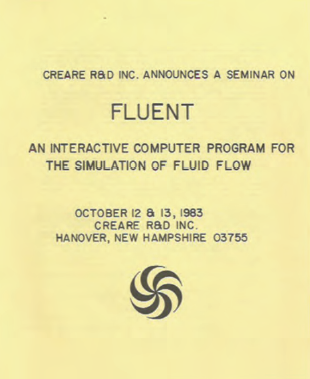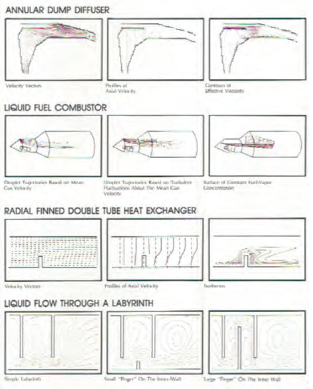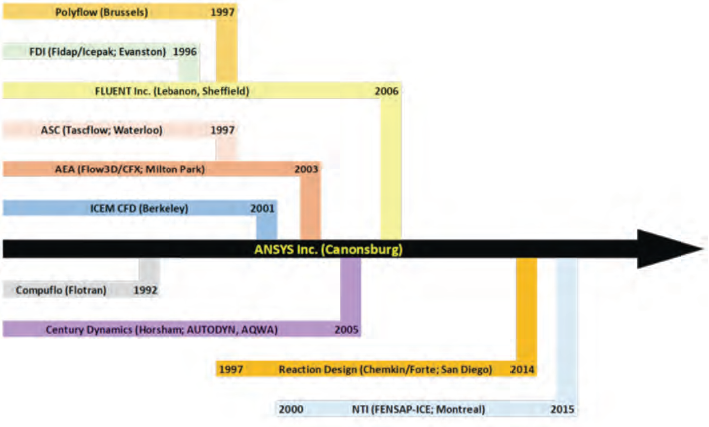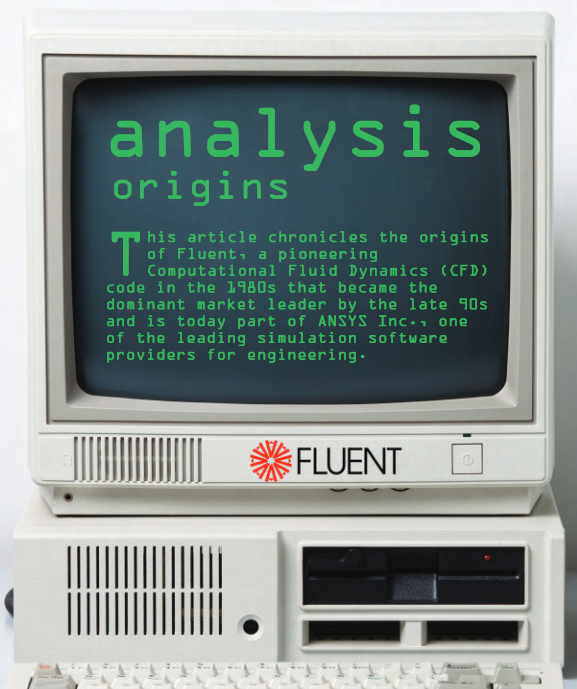This article chronicles the origins of Fluent, a pioneering Computational Fluid Dynamics (CFD) code in the 1980s that became the dominant market leader by the late 90s and is today part of ANSYS Inc., one of the leading simulation software providers for engineering by Bill Kulp
Many of today’s leading software companies emerged from the vision of a single pioneer. Fluent, on the other hand, grew out of the contributions of multiple personalities. The earliest was Hasan Ferit Boysan who came to Sheffield University in the United Kingdom in 1975 for graduate work in fluid mechanics, which at this time was almost universally performed with hand calculations. Boysan met Ali Turan, another student from Turkey, who was working with the Cora3 code, one of the earliest CFD codes developed by Professor Brian Spalding of Imperial College, London to model combustion in a dump combustor. As with the other CFD codes available at this time, users created an input deck of punch cards for Cora3. Errors in the deck were often discovered only after the solver crashed. Turan asked Boysan to help use Cora3 to solve a problem he was working on for his PhD thesis. Progress was slow because every time the researchers changed the geometry or boundary conditions, they had to manually recode the input deck. It was a painful experience, but they achieved enough results for Turan to complete his thesis. Boysan went back to Turkey in 1976 with a reputation of being able to get results from a CFD code.
In 1979, Jim Swithenbank, at the time Professor of Chemical Engineering at the University of Sheffield, invited Boysan back to Sheffield to help him develop a code capable of interactively defining geometry and boundary conditions for a specific problem involving cyclone separators. The resulting software was developed with a student, Bill Ayers as part of his final year research project and was published in the Transactions of the Institute of Chemical Engineers. With the permission of the authors, the editor of the publication added a note that readers could contact the authors to obtain a copy of the source code. Swithenbank and Boysan were surprised to receive several hundred requests for the code, alerting them to the commercial potential of an interactive CFD code.

Figure 1: Painting by Sheffield artist Joe Scarborough, showing locations from Fluent’s UK history.
“The picture is specific to what was the Fluent Europe entity, by local artist, Joe Scarborough, commissioned in 2000 when the company moved to its new premises next to Sheffield Airport (there was an airport) and tracking the history from Sheffield University.
The Sheffield University building on Mappin Street (top left) was where the early version of Fluent was developed. Next to that (narrow red building) is the original office on West Street when Fluent Europe was opened. It was in a few rooms above a book shop, where Ferit Boyson and Bill Ayres worked alongside a very large computer (physically, although not necessarily in terms of computational capacity). The supertram system was installed on West Street when the office was there, creating huge disruption to the center of Sheffield. The advertising hoarding for Rolls-Royce is a nod to them being the largest customer at that time.
Then on the right are the gardens and rear of Holmwood House, the building on Cortworth Road where Fluent Europe moved to in the 90s during expansion. The gardens of Holmwood House show families enjoying picnics – at that time there were a lot of people in the company starting to have families and the summer BBQ was typically a party in the garden. I haven’t been able to find out anything about the greenhouse. When Holmwood House was sold, it was bought by one of the band members of the one-time popular rock combo Def Leopard.
Shown next to Holmwood House is the building at Sheffield Airport Business Park (the ‘Airport’ has subsequently been dropped from the name). Rather ironically the build of the new offices was delayed by delivery of the steel work – which came from Holland – not Sheffield.
The significance of the flags outside the new unit are the Turkish flag reflecting Ferit Boysan’s origins, the Union Jack obviously indicates UK input and the stars & stripes reflect the American ownership – originally Creare. Not sure about the European flag but maybe there was a contribution to the cost of the new building from the EU?
In the distance top left, beyond the somewhat displaced ocean, there is a reference to Ferit’s Turkish background and on the right is the Lebanon office in New Hampshire.
Towards the bottom on the left, you can see a few local details: Jessop’s Hospital (just captured at the far-left) showing an expectant couple (again a reference to the number of young families) and the Red Deer pub that was a likely source of inspiration for those at Sheffield University due to its location next to Mappin Street and later a place that Fluent staff frequented. The football pitch is either capturing the 5-a-side team (that played late 90s to early 00s) or a local acknowledgement to Hallam FC – the oldest ground in the world.
In the foreground people are shown enjoying outdoor pursuits in the Peak District (cycle/ climb/ walk) – a common interest for many staff.
We’re not sure about the sports cars but suspect one (maybe both?) was Ferit’s.
There is a possibility that Ferit and his wife as well as Jim Swithenbank and his wife are shown somewhere too. We suspect Joan Swithenback is standing at the back doorway of Holmwood House.”
Innovative Code made CFD Faster, More Accessible
Boysan and Ayers, a Sheffield graduate student, wrote a general-purpose version of this software that represented a major departure from the CFD codes of that era by featuring an interactive interface that enabled users to graphically change the geometry and boundary conditions and observe the resulting effects. The software also stepped the user through pre-processing, solving and post-processing. Called Tempest, the software could solve a 400-node geometry on the university’s Perkin Elmer 3205 computer that filled a room despite having only 1 megabyte of random-access memory.
Ayers showed the code to Combustion Engineering and Battelle Laboratories in the United States and both companies bought the source code for a few thousand dollars. Swithenbank and Boysan met with the Sheffield University finance director and legal officer and asked if the university wanted to invest in commercializing the code. Searching for an example to explain the business proposition to non-technical people, they pointed to a building in Sheffield which had been designed with a decorative pool. After the building was completed, the flow of air around the building splashed water onto pedestrians and made it necessary to pave over the pool. Swithenbank and Boysan said that Tempest could calculate the flow around the building and predict such problems in advance. The university officials, however, were alarmed to hear this and envisioned the building collapsing and the university being deluged with litigation. They told the erstwhile entrepreneurs that the university wanted nothing to do with their software.
License with Unlimited Support Puts Fluent on Growth Fast Track
Swithenbank freelanced for a consulting company in New Hampshire called Creare and wrote to the company in late 1982 asking for help in commercializing the software. (Over the years, Creare has proven to be a fertile serial company launcher [1].) The letter was passed to Peter Rundstandler, who circulated it to the partners of the firm to ask if anyone was interested in pursuing. Everyone answered no except for Bart Patel who sent a note back to Rundstandler saying “this could be fun.” Ayers installed the code on Creare’s Digital Equipment Company PDP-11 minicomputer and showed it to Patel who liked what he saw. Boysan and Ayers formed a company called Boteb. Creare purchased commercial rights to the software from Boteb, offering a 10% royalty on sales with $25,000 guaranteed and agreed to hire Boteb for at least 1,000 hours of development and support services. Patel felt that the name Tempest sounded too complicated, so he changed it to Fluent to emphasize its ease of use.
“Several key business decisions by the founders in the early years were instrumental in helping distinguish Fluent in the emerging CFD marketplace,” said Dr. S. Subbiah, one of the early employees at Fluent and subsequently a member of its executive team. Other developers of fluid dynamics software at the time sold a perpetual license and charged for support by the hour. Patel felt that users would require a lot of support and if they had to pay by the hour, they would use less support than they needed and end up not achieving results. So, he decided to instead sell an annual license that included unlimited support for a fee close to what competitors were charging for a perpetual license. This was a crucial point of distinction and it played a key role in Fluent’s eventual business success.
Another key decision was to bundle all physics models and solvers in Fluent and to offer it for a single annual lease price. At that time, the market leader CHAM, offered a menu of various modules and solvers — each at their own price. Customers found it hard to determine what solvers and modules they needed upfront, so found Fluent’s single all-in-one price attractive when considering investing in a new technology.
First Fluent Seminar Results in Sales to 80% of Attending Companies
Patel avoided a head-on assault on CHAM by focusing the initial marketing effort on combustion and particularly gas turbines. He asked Boysan and Ayers to add physical models to handle the movement of entrained droplets and particles and to integrate these models into the interactive user interface which set the new software apart.

Figure 2: Cover of invitation to first Fluent seminar

Figure 3: Fluent simulation results from a brochure produced in the early 1980s.
To kick off the marketing effort, in 1983 Patel invited Creare’s clients from leading combustion engineering companies to a seminar (Figure 2). A brochure was prepared on Fluent and distributed to prospective attendees (Figure 3). Patel asked attendees to submit test problems in advance and offered to present solutions during the seminar. Realizing that many of the attendees would be engineers who did not have purchasing authority, he created a video describing the capabilities of the software that attendees could show their managers. About 40 people attended the seminar. The attendees purchased $150,000 worth of software during the seminar and 80% ended up eventually buying Fluent. Patel hired the first employee, Barbara Hutchings, who handled technical support. Hutchings developed a team of customer support engineers that extended the “unlimited technical support” business model to include a sincere focus on doing whatever it took to help the customer become successful with Fluent. This approach helped develop customer loyalty and enabled management to use the support function as the “eyes and ears” of the company to understand where customers were struggling, what projects their management was lining up for them to tackle next, and what competitors were doing.
Fluent used multiple field teams, each focused on selling Fluent to a specific industry segment. These field teams were multi-disciplinary (sales. marketing, customer support and consulting) and they were managed as individual profit centers. “The early team leaders gained a lot of experience in developing a profitable business and many went on to successful management positions at Fluent and elsewhere,” Subbiah said.
Boysan and Ayers remained in Sheffield and did most of the development work through the 1980s. When a problem arose, Patel called Boysan, sometimes in the middle of the night, and Boysan got up and tried to figure out what was going wrong. Boteb became the European distributor of Fluent and was eventually purchased by Fluent and re-christened it Fluent Europe.
Keith Hanna described his experience in 1989 when he was a young researcher at British Steel PLC in Teesside, and the company was choosing between the then market leading general purpose CFD code, PHOENICS from Cham, STAR-CD from Computational Dynamics in London, and Fluent. Hanna said in his blog [2] : “Even back then Brian [Spalding] was viewed as a colossus in the CFD field, and the British Steel Fluid Flow experts were in awe of him. However, PHOENICS then had a very complex multi-code structure with “planets” and “satellites”, as Brian called them, and much scripting between codes. FLUENT with its integrated geometry engine, mesher, solver and postprocessor had less technical capabilities overall but even back then such a simple thing as ease-of-use and user experience had a big impact on potential users and FLUENT was chosen. PHOENICS only worked in batch mode at the time, whereas we liked the fact that you could stop the FLUENT solver during an iteration and view the flow field!”
University Relationships Supplied Key Talent
Patel early on began offering the software at low rates to universities and establishing relationships with key professors in order to obtain their assistance in recruiting their best students. He focused on hiring multi-talented individuals who had a passion for CFD. Candidates were subjected to interviews lasting a day or more. Key early hires included Dipankar Choudhury from University of Minnesota, who is currently Vice President of Research for ANSYS Inc., Wayne Smith from Cornell University, who led the development of Fluent’s unstructured mesh CFD solver and went on to become Senior Vice President Software Development at the CD-adapco business unit of Siemens PLM Software, and Zahed Sheikh, from the University of Iowa, who led the Fluent sales force in the early years and later went on to be an executive at Flomerics.
From a Structured to an Unstructured Mesh
The original Fluent code was a cartesian mesh program which meant that meshes could not be applied to arbitrary computer aided design (CAD) geometries but rather had to be stair-stepped in areas where the boundary was curved. After a few abortive efforts, Boysan, Sergio Vasquez and Kanchan Kelkar developed a boundary fitted version of Fluent in the early 1990s.

Figure 4: Product tree showing ANSYS acquisitions in CFD space
Another limitation of early Fluent was that it utilized structured meshes which were labor intensive in terms of mesh generation and not well suited to modeling complex geometries or capturing flow physics efficiently.
“The Fluent founders made many courageous decisions,” Subbiah said. “One that sticks in my mind was the decision not to pursue block-structured meshing. In the early 1990s, Fluent was a single block code while competitors were offering multi-block solutions that offered significantly greater flexibility in meshing. Although there was strong market pressure on management to develop multi-block technology in Fluent, management decided to leapfrog them by investing in automated, unstructured technology – which, at that time, was largely unproven. This calculated risk led to Fluent leading the industry with the first release of automated unstructured meshing.”
Another Creare employee, Wayne Smith, received Small Business Innovation Research (SBIR) funding from NASA to develop unstructured-mesh CFD software that could adapt during the solution, for example by increasing mesh density in areas with high gradients. After completing the SBIR, Smith and his team, which included Ken Blake and Chris Morley, transferred to Patel’s group within Creare to work on a commercial version of the new software. The results of their work were released in 1991 as the TGrid tetrahedral mesher and Rampant solver which targeted high Mach number compressible flows in aerospace applications.
With Rampant being limited to a relatively narrow range of problems, the original structured mesh Fluent code remained the flagship application through the early 1990s. Several key advances were made on Rampant between 1991 and 1993, however, that were to prove to be vital in Fluent’s future growth. These include the introduction of client-server Cortex architecture, domaindecomposition parallel capability and Joe Maruszewski’s implementation of a pressure-based control-volume finite element method utilizing algebraic multigrid optimized for solving incompressible flow problems. This version was introduced in the market as Fluent/UNS 1.0 in 1994. Later that year, Jayathi Murthy, who at that time led Fluent’s research and development team, and Sanjay Mathur, rewrote Fluent/UNS over a matter of weeks, switching over to a more efficient finite-volume formulation well-suited for building in methods and physics for the majority of CFD applications. This version of the code was released as Fluent/UNS 3.2 in 1995. Murthy went on to an illustrious academic career and is currently Dean of Engineering at the University of California Los Angeles. Rampant and Fluent/UNS continued as concurrent codes for several years and were combined into a single code with release 5 in 1998, the original structured mesh Fluent code to be discontinued. With Fluent 5, all the major ingredients of a potent CFD modeling capability were together in a single offering – unstructured mesh methods for the entire range of flow regimes, and a client-server architecture with an easy-to-use interactive user interface well suited to run on parallel supercomputers or clusters of the new generation of workstations made by Silicon Graphics, Sun and Hewlett-Packard.
Avid Thermalloy Provides Capital for Growth
Fluent spun off from Creare in 1991 with Creare retaining a substantial minority stake. Patel talked to several investment banks seeking funding to buy out Creare’s stake and take the company to the next level, but despite Fluent generating a considerable cash flow they were not interested in financing a leveraged buyout. Patel happened to play golf during this period with the CEO of Aavid Thermalloy, a New Hampshire company producing heat sinks for electronics applications. Aavid was also looking for capital, so Fluent merged with Aavid and the combined company issued an Initial Public Offering (IPO) in January 1996 that made it possible to buy out the Creare shareholders and fund the expansion of the business.
The IPO also made it possible to issue stock options to employees and acquire several competitive CFD software companies to obtain their technology and engineering teams. These included Fluid Dynamics International and its FIDAP general purpose CFD software, and Polyflow S.A., whose Polyflow CFD software was designed to handle laminar viscoelastic flows. In January 2000, Willis Stein & Partners, a private equity investment firm, acquired the Aavid Thermal Technologies business unit. Meanwhile, Fluent sales grew from $8 million in 1995 to $100 million in 2004.
Acquisition by ANSYS, Inc.
In May 2006, Fluent Inc. was acquired by ANSYS, Inc., a computer aided engineering software company that up to that point specialized in solid mechanics simulation. A product tree showing ANSYS CFD acquisitions is shown in Figure 4. When ANSYS acquired Fluent, the two companies were roughly equal in revenues and as a result, former Fluent employees had a considerable influence on the operation of the combined company.
Brian Spalding, universally considered to be the father of the CFD industry, best defined the influence of Fluent on the CFD industry. Spalding once said that the company he founded, CHAM, showed the world that fluid dynamics problems could be solved on a computer. He said that Fluent, on other hand, proved that engineers could use this software to solve real world problems. His statement reaffirms the success of Fluent in achieving its initial goals of providing interactive software combined with strong technical support that enabled engineers to, quoting the original 1983 Fluent brochure, “apply stateof- the-art computer simulation methods to analyze and solve practical design problems without costly, timeconsuming computer programming.”
By Bill Kulp is the Lead Product Marketing Manager for Fluids at ANSYS. An engineer, Bill is passionate about promoting technology that makes our lives better. For over 25 years, he has been marketing complex software products across the globe including medical diagnostic imaging, pharmacy automation and now engineering simulation. He would love to hear from you how CFD simulation is making your products better!
References
[1] Creare, “Spin-offs,” 2016. [Online]. Available: nafe.ms/2VsPYsN. [2] K. Hanna, “Brian Spalding: The Founding Father of Commercial CFD Passes Away,” Mentor, 2016. [Online].

